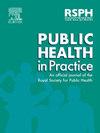Determinants of loss to follow-up among people living with HIV receiving antiretroviral therapy in a universal test and treat setting: A retrospective cohort study in Nepal
IF 1.9
Q2 PUBLIC, ENVIRONMENTAL & OCCUPATIONAL HEALTH
引用次数: 0
Abstract
Objectives
This study aims to assess the cumulative incidence and rate of loss to follow-up (LTFU) among people living with HIV (PLHIV) in Nepal who begin antiretroviral therapy (ART) early, as well as to identify factors associated with LTFU in the context of the universal test and treat approach.
Study design
Retrospective cohort study.
Methods
We retrospectively analysed nationally representative routine programme data for all PLHIV initiated on ART from February 19, 2017, to February 18, 2020, and followed up until May 10, 2022. LTFU was defined as a client not returning to the HIV clinic for at least 3 months from the date of their last scheduled appointment. We calculated cumulative incidence rate (IR) and used a multivariable Cox proportional hazards regression model to identify factors associated with LTFU, reporting corresponding 95% confidence intervals (CI).
Results
Of the 8192 clients included in our sample, 6797 (82.9 %) started ART within seven days following their HIV diagnosis. The overall IR of LTFU was 4.22 (95 % CI = 3.95–4.51) per 100 person years of observation. The cumulative incidence of LTFU increased over time on ART, from 3.81 % (95 % CI = 3.40–4.26) at 6 months, 6.51 % (95 % CI = 5.97–7.09) at 12 months to 13.41 % (95 % CI = 12.51–14.37) at 48 months. In the multivariable model, factors associated with higher odds of LTFU included initiating treatment within 7 days of diagnosis, younger age, being unmarried, belonging to the Dalit caste, having WHO clinical stage 1 at baseline, and initiation on a non-nucleoside reverse transcriptase inhibitors (NNRTI)-based regimen. Among key populations, sex workers, their clients, men who have sex with men and transgender, people who inject drugs were at higher risk of dropout compared to migrants.
Conclusions
In this nationwide cohort, the risk of LTFU increased with time on ART. To optimize the test-and-treat strategy in Nepal, it is crucial to address the unique needs of youth and certain key populations and manage any early adverse drug reactions.
在普遍检测和治疗环境中接受抗逆转录病毒治疗的艾滋病毒感染者随访损失的决定因素:尼泊尔的一项回顾性队列研究
本研究旨在评估尼泊尔早期开始抗逆转录病毒治疗(ART)的HIV感染者(PLHIV)的累积发病率和随访失踪率(LTFU),并在普遍检测和治疗方法的背景下确定与LTFU相关的因素。研究设计回顾性队列研究。方法回顾性分析2017年2月19日至2020年2月18日期间所有接受抗逆转录病毒治疗的艾滋病毒感染者的全国代表性常规规划数据,并随访至2022年5月10日。LTFU被定义为客户从最后一次预约之日起至少3个月内未返回HIV诊所。我们计算累积发病率(IR),并使用多变量Cox比例风险回归模型来确定与LTFU相关的因素,报告相应的95%置信区间(CI)。在纳入我们样本的8192名患者中,6797名(82.9%)在其HIV诊断后7天内开始抗逆转录病毒治疗。LTFU的总体IR为每100人观察年4.22 (95% CI = 3.95-4.51)。LTFU的累积发生率随着ART治疗时间的推移而增加,6个月时为3.81% (95% CI = 3.40-4.26), 12个月时为6.51% (95% CI = 5.97-7.09), 48个月时为13.41% (95% CI = 12.51-14.37)。在多变量模型中,与LTFU发生率较高相关的因素包括:在诊断后7天内开始治疗、年龄较小、未婚、属于达利特种姓、基线时处于WHO临床1期,以及开始使用基于非核苷类逆转录酶抑制剂(NNRTI)的方案。在关键人群中,性工作者、他们的客户、男男性行为者和变性人、注射毒品的人比移民有更高的辍学风险。结论:在这个全国性队列中,LTFU的风险随着抗逆转录病毒治疗时间的延长而增加。为了优化尼泊尔的检测与治疗战略,必须解决青年和某些关键人群的独特需求,并管理任何早期药物不良反应。
本文章由计算机程序翻译,如有差异,请以英文原文为准。
求助全文
约1分钟内获得全文
求助全文

 求助内容:
求助内容: 应助结果提醒方式:
应助结果提醒方式:


